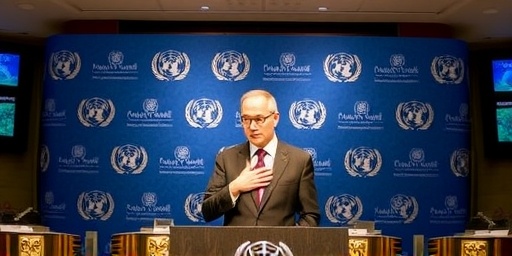In a bittersweet finale to the latest UN climate talks in Geneva, world leaders pledged billions in financial aid to help developing countries combat climate disasters, yet the conference ended without any binding commitments to curb fossil fuel use. This outcome highlights the ongoing tug-of-war between immediate economic relief and long-term environmental imperatives, leaving many nations in limbo as extreme weather events intensify.
The two-week negotiations, attended by over 190 countries, saw delegates hammer out a framework for annual financial aid totaling $100 billion starting in 2025. This funding aims to support adaptation measures in regions hardest hit by rising sea levels and droughts. However, the absence of explicit targets for phasing out fossil fuels—despite urgent calls from scientists—has drawn sharp criticism from environmental groups, who warn that it perpetuates a reliance on polluting energy sources that exacerbate the global crisis.
Representatives from small island states and African nations expressed frustration, noting that without tackling fossil fuels head-on, the promised financial aid may only serve as a band-aid for deeper economic vulnerabilities. As one delegate put it, “We’re getting money to clean up the mess, but no plan to stop the polluters from making it worse.”
Financial Aid Deal Emerges After Marathon Negotiations
The breakthrough on financial aid came late into the night on the final day of the UN climate talks, following intense bargaining sessions that stretched well past midnight. Developing countries, which contribute the least to global emissions but suffer disproportionately from their effects, pushed hard for concrete funding mechanisms. The resulting agreement commits wealthy nations to mobilize $100 billion annually by 2025, up from previous vague promises that often fell short.
Under the deal, funds will be channeled through a newly established UN-managed trust to finance projects like resilient infrastructure, renewable energy transitions, and agricultural adaptations. For instance, Bangladesh, frequently battered by cyclones, could receive up to $500 million for coastal defenses, while sub-Saharan African countries might allocate resources to drought-resistant farming techniques. “This is a lifeline for our economies,” said Aisha Rahman, a negotiator from Kenya, emphasizing how climate impacts have already shaved 2-5% off GDP in vulnerable regions according to World Bank estimates.
Yet, the financial aid package isn’t without strings. Contributors like the United States and European Union insisted on transparency clauses to ensure funds aren’t diverted, and there’s a phased increase tied to economic recovery post-pandemic. Critics argue this could delay disbursements, as seen in past climate funds where only 20% of pledged money materialized on time. Still, the agreement marks a step forward, potentially injecting stability into the economies of developing countries that face annual losses of up to $1 trillion from climate-related damages, per IPCC reports.
To illustrate the scale, consider the Pacific island nation of Kiribati, where rising seas threaten to submerge entire communities. The aid could fund relocation programs and mangrove restoration, preserving both lives and local economies dependent on fishing and tourism. Economists project that without such support, global inequality could widen, with developing countries’ growth rates lagging 1-2% behind resilient peers.
Fossil Fuel Phase-Out Talks Crumble Under Industry Pressure
While financial aid provided a glimmer of hope, the UN climate talks faltered spectacularly on addressing fossil fuels, the primary driver of greenhouse gas emissions. Proposals to set 2030 targets for reducing coal, oil, and gas production were watered down repeatedly, ultimately vanishing from the final text. This outcome reflects the influence of major fossil fuel exporters like Saudi Arabia and Russia, who argued that abrupt cuts would devastate their economies without viable alternatives.
Environmental advocates had entered the talks optimistic after last year’s COP27 emphasized “phasing down” unabated fossil fuels. But lobbying from oil giants, including ExxonMobil and Shell, reportedly swayed key delegates. A leaked document revealed that fossil fuel subsidies—totaling $7 trillion globally in 2022, according to the IMF—continue to undercut renewable investments. Without explicit measures, emissions could rise 10-20% by 2030, experts warn, undermining Paris Agreement goals.
“It’s a betrayal of the science,” stated Greta Thunberg in a post-talks statement, echoing sentiments from over 100 civil society groups. The failure leaves a void: while renewables like solar and wind now cost less than fossil fuels in many markets, transitioning requires policy signals that the talks couldn’t deliver. For developing countries, this means continued dependence on imported fossil fuels, straining budgets already burdened by debt—external debt in low-income nations hit $1.1 trillion last year, per UN data.
One silver lining? Side agreements encouraged voluntary national plans for fossil fuel reductions, with Brazil and India pledging exploratory cuts in coal use. However, without enforcement, these remain aspirational, highlighting the economy’s tangled ties to fossil fuels, which still power 80% of global energy needs.
Developing Countries Bear the Brunt of Economic Uncertainties
The rift over fossil fuels has profound implications for developing countries, whose economies are on the frontlines of climate disruption. Nations like Pakistan and Ethiopia, reeling from 2022 floods and droughts that displaced millions, now face uncertain futures without a clear path to decarbonization. The financial aid promise offers short-term relief, but experts say it’s insufficient without fossil fuel reforms to stabilize global markets.
Consider the economic ripple effects: volatile fossil fuel prices, exacerbated by the Ukraine conflict, have driven inflation in import-dependent economies. In Africa, where 600 million people lack electricity, reliance on coal and oil hampers growth while renewables sit idle due to funding gaps. The UN climate talks’ failure to address this perpetuates a cycle where developing countries subsidize the Global North’s historical emissions through lost productivity—estimated at $2.5 trillion annually by 2030 if unchecked.
Quotes from the ground underscore the stakes. “Our farmers are starving while oil barons profit,” lamented Bolivian Environment Minister Elena Vargas, pointing to how fossil fuel-driven weather extremes have halved crop yields in the Andes. Similarly, Vietnamese officials highlighted sea-level rise threatening $10 billion in annual rice exports. To mitigate, some countries are turning to bilateral deals; for example, China’s Belt and Road Initiative has funded solar projects in 20 African nations, bypassing UN delays.
Statistically, the World Economic Forum ranks climate inaction as the top global risk, with developing economies projected to lose 11% of GDP by 2050 under current trajectories. The talks’ aid focus could buffer this somewhat, but integrating fossil fuel cuts is essential for sustainable growth, potentially unlocking $26 trillion in green economy opportunities by 2030, per IRENA forecasts.
Global Reactions and Calls for Urgent Reforms
Reactions to the UN climate talks poured in swiftly, with a mix of cautious optimism on financial aid and outrage over fossil fuel inaction. UN Secretary-General António Guterres called the aid pledge “a vital step,” but urged, “We must now confront the elephant in the room: fossil fuels.” Youth activists staged protests outside the venue, chanting for “real action, not empty promises,” while business leaders from the renewable sector praised the funding as a boon for green tech investments.
In the U.S., President Biden’s administration hailed the deal as fulfilling campaign pledges, though domestic fossil fuel lobbies decried it as insufficient for energy security. Europe’s Green Deal advocates pushed for EU-led initiatives to fill the fossil fuel gap, proposing a carbon border tax on imports from high-emission nations. Meanwhile, developing countries formed a bloc to monitor aid delivery, vowing to withhold cooperation on other UN agendas if pledges falter.
The talks also spotlighted gender and indigenous perspectives; women in developing countries, who comprise 70% of the poor, are hit hardest by climate shifts. Indigenous leaders from the Amazon demanded recognition of traditional knowledge in aid allocation, citing successful community-led reforestation that sequesters millions of tons of CO2 yearly.
Broader context reveals a pattern: previous UN climate talks, like COP26 in Glasgow, similarly stalled on fossil fuels despite high rhetoric. This iteration’s aid focus aligns with post-COVID recovery needs, where developing countries seek $4 trillion in total climate finance. Economically, the impasse risks investor flight from fossil-dependent markets, with $4 trillion already divested globally since 2015.
Path Forward: Bridging the Gap to Net-Zero Ambitions
As the dust settles from the UN climate talks, attention shifts to implementation and the next round of negotiations in 2024. The financial aid mechanism must be operationalized swiftly, with annual reporting to track progress and adjust for inflation or escalating disasters. Developing countries are already mobilizing: a coalition of 50 nations plans to launch a “Climate Resilience Fund” to leverage the UN pledge for immediate projects, targeting 100 million beneficiaries by 2030.
On fossil fuels, momentum builds outside formal channels. The High-Level Expert Group on Net-Zero Emissions recommends tripling renewable capacity by 2030, a goal echoed in G20 discussions. Private sector innovation could accelerate this; companies like Tesla and Ørsted are scaling battery storage and offshore wind, potentially cutting costs 50% in the coming decade. For economies in transition, blended finance—mixing public aid with private capital—offers a model, as seen in Morocco’s Noor solar complex, which powers 1 million homes without fossil inputs.
Looking ahead, success hinges on political will. If financial aid flows reliably, it could catalyze green jobs, creating 18 million positions in developing countries by 2030 per ILO projections. Yet, without fossil fuel curbs, the world risks breaching 1.5°C warming, triggering irreversible tipping points like permafrost thaw releasing methane. Stakeholders urge interim measures: national carbon budgets, international trade pacts for clean tech, and youth involvement in policy design.
Ultimately, the talks underscore that climate action is inseparable from economic justice. Bridging this divide requires not just money, but a global compact to dismantle fossil fuel dominance, ensuring a equitable path to sustainability for all nations.









